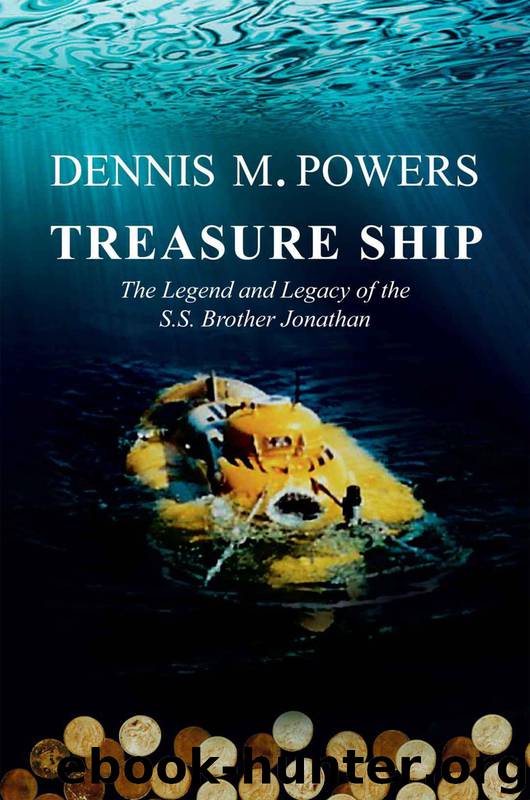Treasure Ship: The Legend and Legacy of the S.S. Brother Jonathan (The Maritime Series of Sea Ventures Press) by Powers Dennis M

Author:Powers, Dennis M. [Powers, Dennis M.]
Language: eng
Format: epub
Publisher: Sea Ventures Press
Published: 2015-01-03T22:00:00+00:00
With the state official looking on and entirely unaware that a carronade had already been recovered, the treasure hunter raised a second one. The piece was still packed with hemp and a charge, ready to fire. Harrington solemnly pretended that it was the first artifact to come up.
Armed with his salvage permit (the ship was well within Delaware’s three-mile coastal limit), Harrington filed his legal action to “arrest” the ship as the salvor. The court quickly granted him the order decreeing that Sub-Sal was the wreck’s legal custodian. After telling the public about his find and raising more investment capital, Harrington continued salvaging the wreck. The exploration was difficult at the site—as all such operations are for one reason or another—due this time to the strong underwater tides that raced back and forth at speeds up to 10 miles per hour. This created difficulties for movement as well as visibility.
Sub-Sal decided to use teams of divers with surface air feeds from a mother craft, the Mariner, which anchored over the wreck with a four-point mooring system. Another line supplied electricity for the diver’s helmet light, and a communication line provided voice contact. As the DeBraak had settled in relatively shallow waters, its divers only spent thirty minutes in a decompression chamber for each one-hundred minutes spent getting to the bottom and back.
From pistols and cannonballs to shoes, rum bottles, and bowls, the divers brought up hundreds of artifacts—but no treasure. The lease with Delaware provided that a state representative be on board the mother ship at all times during operations. As an ever increasing number of the artifacts were catalogued, the quantities began to tax the ability of the state to properly oversee their conservation.
In his book, Shomette charged that the divers inappropriately “disturbed” the bones of the dead. Soon thereafter, they brought up some one hundred coins, mostly Spanish gold doubloons from the mid-1790s that the English had looted from the Spanish ships they had stopped. Without any cash flow allowed from the discovered artifacts, coins, and jewelry, however, the costs of the continuing operations outstripped Harrington’s ability to pay his bills.
He was forced to lay off employees. Shomette alleged that “a thirty-pound clump of oxidized silver coins of nearly two hundred Spanish pieces of eight were taken back down and ‘rediscovered!’” Later, after several anonymous telephone calls, the Delaware State Police searched the storage premises and a safe deposit box, discovering that Harrington (according to Shomette’s research) had sent “more than one hundred coins” plus jewelry for appraisal and sale by an out-of-state company. As the state had permitted only coins and jewelry “deemed not historical” to be sold, the author charged Harrington was in violation of Sub-Sal’s lease.
After five months of salvage work, the operators discovered and brought up over one thousand artifacts, but limited treasure that was marketable. As his company’s cash flow deteriorated, two investors finally sued Harrington for breach of contract over the amount of treasure to be received. The State of Delaware refused to renew Sub-Sal’s salvage lease.
Download
This site does not store any files on its server. We only index and link to content provided by other sites. Please contact the content providers to delete copyright contents if any and email us, we'll remove relevant links or contents immediately.
Small Unmanned Fixed-wing Aircraft Design by Andrew J. Keane Andras Sobester James P. Scanlan & András Sóbester & James P. Scanlan(32692)
Navigation and Map Reading by K Andrew(4972)
Endurance: Shackleton's Incredible Voyage by Alfred Lansing(4635)
And the Band Played On by Randy Shilts(2087)
Top 10 Prague (EYEWITNESS TOP 10 TRAVEL GUIDES) by DK(1903)
Wild Ride by Adam Lashinsky(1903)
The Box by Marc Levinson(1902)
The Race for Hitler's X-Planes: Britain's 1945 Mission to Capture Secret Luftwaffe Technology by John Christopher(1770)
The One Percenter Encyclopedia by Bill Hayes(1762)
Trans-Siberian Railway by Lonely Planet(1669)
Girls Auto Clinic Glove Box Guide by Patrice Banks(1656)
Looking for a Ship by John McPhee(1611)
Batavia's Graveyard by Mike Dash(1588)
TWA 800 by Jack Cashill(1570)
Fighting Hitler's Jets: The Extraordinary Story of the American Airmen Who Beat the Luftwaffe and Defeated Nazi Germany by Robert F. Dorr(1548)
Good with Words by Patrick Barry(1547)
Troubleshooting and Repair of Diesel Engines by Paul Dempsey(1534)
Ticket to Ride by Tom Chesshyre(1524)
Bligh by Rob Mundle(1523)
